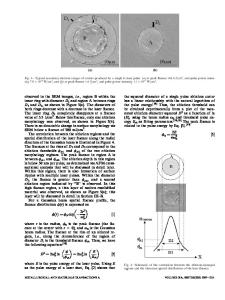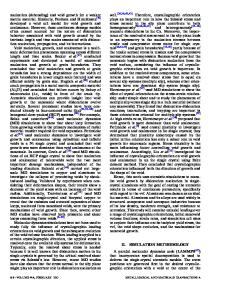Dynamics of Ultrafast Laser Induced Damage in Single Crystal Ni-based Superalloy During Machining
- PDF / 243,101 Bytes
- 6 Pages / 612 x 792 pts (letter) Page_size
- 66 Downloads / 306 Views
0980-II05-31
Dynamics of Ultrafast Laser Induced Damage in Single Crystal Ni-Based Superalloy During Machining Joel P. McDonald1, Shuwei Ma2, John A. Nees3, Tresa M. Pollock2, and Steven M. Yalisove2 1 Applied Physics, University of Michigan, B122 Gerstacker Building, 2200 Bonisteel Blvd., Ann Arbor, MI, 48109 2 Materials Science and Engineering, University of Michigan, Ann Arbor, MI, 48109 3 Center for Ultrafast Optical Science, University of Michigan, Ann Arbor, MI, 48109
ABSTRACT Pump-probe imaging of femtosecond pulsed laser ablation was performed to investigate the mechanical shock induced on an intermetallic superalloy CMSX-4 during femtosecond laser machining. Time resolved shadowgraphic images were collected of the shock wave produced in the air above the target following laser exposure (0–10.3 nanoseconds). The dimensions of the shock wave were measured as a function of delay time and laser fluence (1.27 J/cm2 – 62.8 J/cm2). Time-resolved shadowgraphic images of the ablation event will be presented, and the corresponding damage morphology as a function of incident laser fluence will be discussed. INTRODUCTION The femtosecond (fs) pulsed laser exhibits several advantages over conventional micromachining technologies including limited collateral damage and heat affected zones [1-3], with the added ability to machine submicron features [4, 5]. These advantages can be attained only when machining with laser fluences near the ablation threshold [6-9] where a non-thermal ablation mechanism results in material removal. Recently, fs laser machining studies on the Ni based superalloy CMSX-4 have been performed to investigate the use of such a laser for machining cooling channels in turbine blades [10]. In this work, the dynamics of single pulse fs laser ablation of CMSX-4 superalloy and resulting ablation morphology were studied as a function of laser fluence in order to develop the physics underlying fs laser ablation and the resulting damage morphologies. Ultrashort pulsed lasers provide techniques to observe dynamic events with otherwise unavailable temporal resolution. By using the ultrashort laser pulse as a probe, excited carrier and lattice dynamics in metals [11] and semiconductors [12], and even hydrogen bonds in liquid water [13] have been studied with time resolution only limited by the laser pulses temporal width. Pump-probe microscopy of fs laser ablation was first performed in the front-view imaging geometry, where an image is formed from a probe pulse that has reflected off of the surface of a sample irradiated with an energetic pump laser pulse [14]. More recently, side-view or shadowgraphic imaging geometry has been pursued in which an image is formed from a probe
laser pulse that has passed laterally through the ablation event produced by an ablating pump pulse [15, 16]. Up to this point, time resolved shadowgraphic imaging of fs laser ablation has been applied to silicon alone, with limited variation in pump laser fluence (1.5 J/cm2 [15], 11 J/cm2 [16]). In the work presented here, pump-probe
Data Loading...









